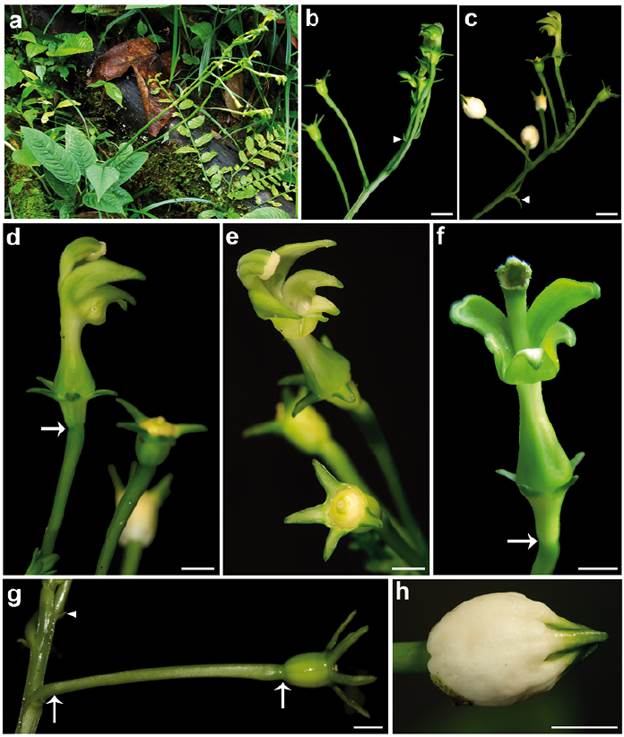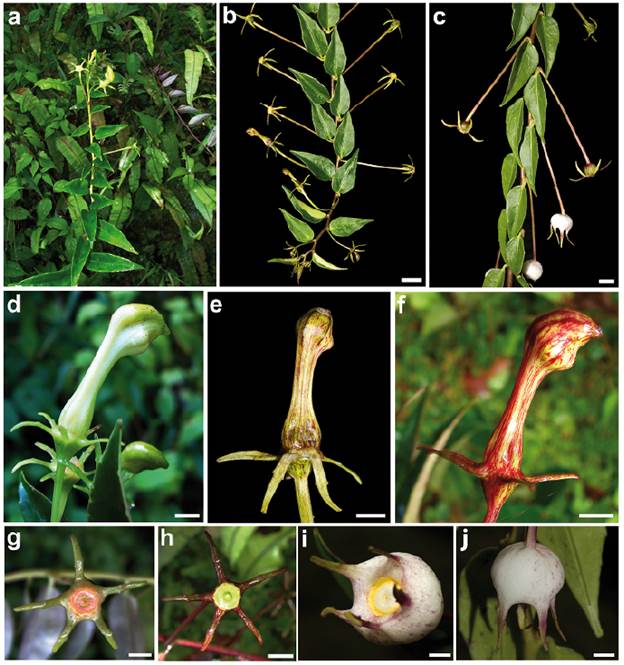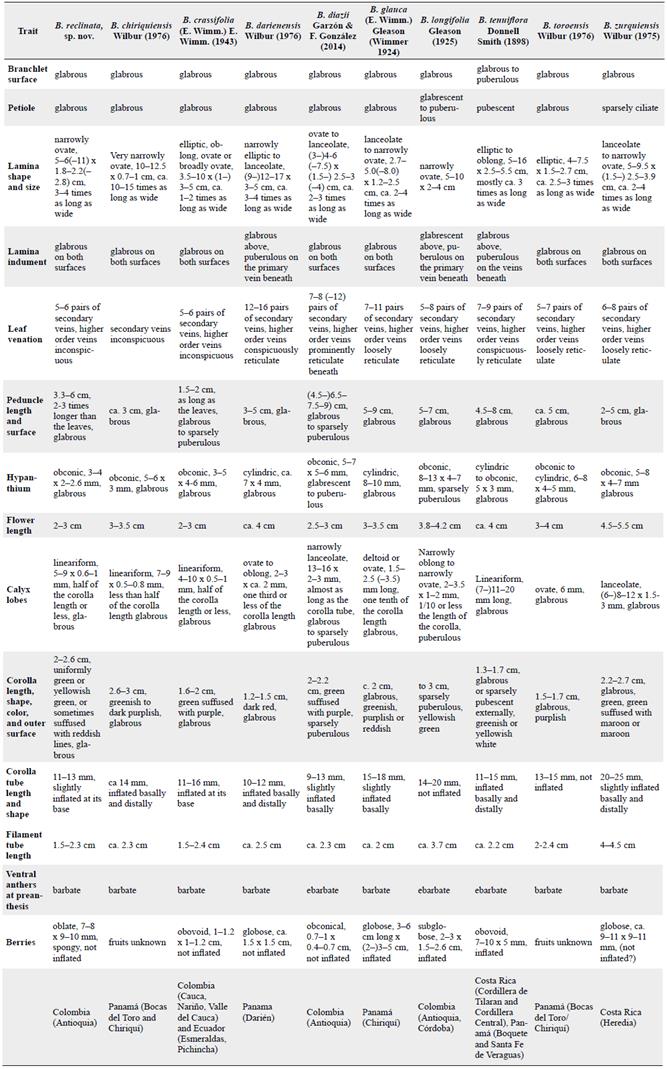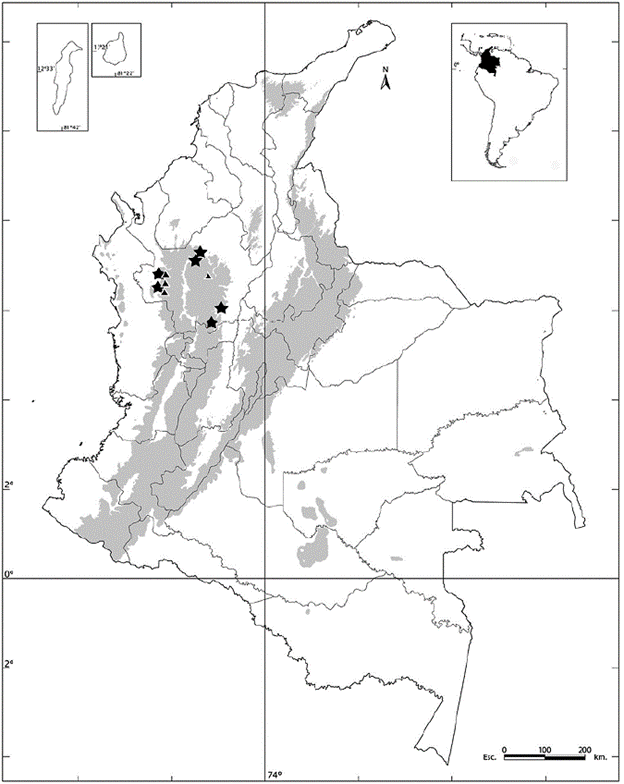INTRODUCTION
The neotropical Lobelioideae (Campanulaceae), especially the clade with the sister genera Burmeistera, Centropogon and Syphocampylus, have recently been recognized as exceptional in terms of rapid speciation rates that appear to be correlated to the uplift of the Andes, and the biotic agents involved in pollination and seed dispersal (Lagomarsino et al. 2016). With over 120 species distributed from Honduras to Peru, Burmeistera is one of the most diversified genera in this clade. The majority of species in the genus are terrestrial herbs to subshrubs, which often exhibit hemi-epiphytic or climbing habits. Flower shapes and colors in Burmeistera are highly adapted primarily to bat pollination, but in some cases hummingbird or insect visitors have also been reported (Muchhala 2006, 2007a, b, Muchhala and Potts 2007). The most conspicuous synapomorphy for the genus is the dilated opening of the anther tube (Fig. 1). In contrast to the well known mechanisms of pollination in the genus, fruit or seed dispersal is less known (Gamba et al. 2017).

Figure 1 Burmeistera fistulosa F. González & J. M. Vélez, sp. nov. a. Entire plant; b. Corymb; c. Corymb with some mature berries; d-f. Flowers, lateral (d), oblique (e) and ventral (f) views; some forming berries are apparent at d and e; g. Peduncle and forming berry; h. Mature berry. Arrows point to abscission zones of peduncle; arrowheads point to subtending bracteiform leaves. (a, f. Betancur et al. 15048, photos J. Vélez-Puerta; b-e, h, Pedraza-Peñalosa et al. 1981, photos F. Gómez); g, Pedraza-Peñalosa et al. 2030 (photo M. F. González). Scale bars = 5 mm.
Until recently, the taxonomic studies of this genus, described by the Colombian botanist J. J. Triana (1854), were based upon herbarium specimens, but recent field expeditions to unexplored areas in Colombia have unveiled 11 new species described in a six year period (Garzón-Venegas and González 2012, 2014, Garzón-Venegas et al. 2012, 2013, 2014). Two sets of collections primarily from the Parque Nacional Natural Las Orquídeas, in the department of Antioquia (Colombia), have called our attention because they do not match any of the known species of Burmeistera from Colombia or neighboring countries (Wimmer 1943, 1953, 1968, McVaugh 1965, Wilbur 1975, 1976, 1981, Jeppesen 1981, Lammers 1998, 2002). Given that their traits are consistently found in the specimens at hand in the Herbario Nacional Colombiano, Universidad Nacional de Colombia, Bogotá (COL), Herbario de la Universidad de Antioquia (HUA), Herbario de la Universidad Nacional de Colombia, sede Medellín (MEDEL), and the New York Botanical Garden herbarium (NY), we proceed to describe these two new species.
MATERIALS AND METHODS
The terminology used for the descriptions follows primarily Jackson (1900) and Hickey and King (2000). All the type specimens for the species similar to the new taxa here described were consulted through JSTOR (https://plants.jstor.org/) or directly examined at the herbaria COL, HUA, MEDEL and NY.
RESULTS AND DISCUSSION
Burmeistera fistulosa F. González & J. M. Vélez, sp. nov. TYPE: Colombia. Antioquia: Urrao, corregimiento de Encarnación, Parque Nacional Natural Las Orquídeas, sector Calles, cerca de la cabaña de Parques, margen izquierda del río Calles, 6°31'08" North, 76°15'59" West, 1340 m, 7 abr 2011 (fl, fr), J. Betancur, J. M. Vélez-Puerta, P. Pedraza, J. M. Orejuela & A. Duque 15048 (holotype MEDEL [MEDEL 56096], isotypes COL, MEDEL [56095], NY). (Figs. 1, 3)

Figure 2 Burmeistera reclinata F. González & J. M. Vélez. a. Entire plant; b, c. Pendant reproductive branchlets; d-f. Flowers, lateral views; note color variation from yellowish-green (d), to predominantly reddish; g-h. Top view of the hypanthium and calyx lobes during fruit development; note color variation of yellowish-green (g) and reddish (h) calyx lobes; i-j. Berries, oblique (i) and lateral (j) views. (a, d, f-h, Betancur et al. 15226, photos J. M. Vélez-Puerta; b, c, e, i, j, Pedraza-Peñalosa et al. 2304, holotype, photos M. F. González). Scale bars = 5 mm.
Species similar to Burmeistera tomentosula H. Karst. & Triana, from which it differs by the glabrous surfaces, the leaves with petiole 1. 4-2 cm long and lamina elliptic to ovate, glabrous beneath, the extremely reduced subtending leaves, the calyx lobes 2.5-3.5 x 0.8-1.2 mm, the corolla glabrous, the ventral anthers barbate, and the berries white and obconic to ellipsoid (versus pubescent surfaces, leaves with petiole 2-6 cm long and lamina elliptic to narrowly obovate, puberulous beneath, the subtending leaves not greatly reduced, the calyx lobes 5-10 x 2-4 mm, the corolla densely puberulous, the ventral anthers ebarbate, and the berries pink and subglobose in B. tomentosula).
Glabrous herbs to 1 m tall. Petiole 1.4-2 cm long, glabrous; lamina elliptic to ovate, (3.5-) 9.5-14 x (2.8-) 4-6 cm, base obtuse, round to slightly cordate, asymmetric, apex acute to shortly acuminate, margin finely serrulate, with 30-40 evenly distributed callose teeth on each side, glabrous on both surfaces, secondary veins 10-14 pairs, higher order venation conspicuously reticulate, submarginal vein present but discontinuous. Flowers densely arranged in a corymb in the distal portion of the branch with shortened internodes, each flower axillary to a glabrous, bracteiform, scaly or filiform reduced leaf to 4 x 1 mm. Floral peduncle 2-4.8 (6 in fruit) cm long, thick (in vivo), fistulous and pale yellow (in siccus), with a proximal and a distal constriction (likely functioning as abscission zones), ebracteolate. Hypanthium obconic, 4-5 x 2-2.5 mm, glabrous. Floral buds glabrous. Calyx lobes very narrowly ovate, 2.5-3.5 x 0.8-1.2 mm, forming broad (ca. 1 mm) sinuses between them, green; corolla 1.8-2.3 cm long, green, sometimes tinted maroon, glabrous, tube slightly inflated at its base, 8-12 mm long, ca. 1 mm in diam., lobes arranged at angles of 120-140° with respect to the tube, slightly falcate, dorsal lobes 7-9 x 2.5-3 mm, lateral lobes 6.5-8 x 2.5-3 mm, ventral lobe 5.5-6.5 x 2-2.5 mm, inflated at its base; synandrium exserted by 5 mm from the sinus between the dorsal lobes; filament tube green, finely puberulous; anther tube green, ventral anthers barbate at preanthesis and early anthesis. Berries obconic to ellipsoid, 8-10 x 4-8.5 mm, glabrous, green when juvenile, then white, not inflated, crowned by the green, persistent and slightly acrescent (to 9 mm long) calyx lobes.
Paratypes. COLOMBIA. Antioquia: Urrao, corregimiento de Encarnación, Parque Nacional Natural Las Orquídeas, sector Calles, camino hacia La Virgen, 14 abr 2011 (fl, fr), J. Betancur, J. M. Vélez-Puerta, P Pedraza, J. M. Orejuela & A. Duque 15232 (COL, MEDEL); Frontino, corregimiento Nutibara, region of Murrí, Alto de Cuevas, ca. 6°45' North, 75°20' West, 1500-1880 m, 16-18 oct 1987 (fl), J. L. Luteyn et al. 11699 (HUA, NY); Frontino, corregimiento Nutibara, region of Murrí, Altos de Cuevas, ca. 6°45' North, 75°20' West, 1500-1880 m, 16-18 oct 1987 (fl, fr), J. L. Luteyn et al. 11717 (HUA, NY); Urrao, corregimiento de Encarnación, Parque Nacional Natural Las Orquídeas, vereda Calles, Parque Nacional Natural Las Orquídeas, en el camino de la cabaña a la quebrada El Agudelo, 6°31'5" North, 76°15'9" West, 1351 m, 26 ene 2011 (fl, fr), P. Pedraza-Peñalosa et al. 1981 (COL); Urrao, corregimiento La Encarnación, vereda Calles, Parque Nacional Natural Las Orquídeas, finca de Alfonso Pino, divisoria de aguas entre las quebradas La Virola y El Bosque, al noroccidente de la cabaña de Calles, 6°31'35" North, 76°15'50" West, 1450-1470 m, 27 ene 2011 (fl), P. Pedraza-Peñalosa et al. 2030 (COL, NY); Frontino, Parque Nacional Natural Las Orquídeas, vereda Venados Abajo, después de la finca Vista Hermosa, divisoria de aguas entre el río Venado y Quebrada La Selva, 6°33'13" North, 76°18'54.3" West, 1240-1280 m, 25 jul 2011 (fl, fr), P. Pedraza-Peñalosa et al. 2334 (COL).
Etymology. The specific epithet refers to the thick peduncle that becomes fistulose and pale yellow at late anthesis.
Distribution, habitat, conservation and phenology. Burmeistera fistulosa has been collected only in the department of Antioquia (Colombia). The species grows at the edges of primary or secondary forests between 1240 and 1880 m in elevation, including Quercus humboldtii forests. The species has been found setting flowers and fruits in January, April, July and October.
General comments. The new species is distinguishable by a corymbose flowering portion of the branchlets, and the fistulous floral peduncle with two well defined constrictions that likely facilitate fruit dispersal by providing break-joints allowing the fruit to be easily removed from the plant. These two traits resemble those found in Burmeistera tomentosula H. Karst. & Triana, from Cauca, Nariño, Quindío and Valle del Cauca. However, they stand as two separate species, as they consistently differ in the following set of characters: Burmeistera fistulosa is glabrous, the petiole is 1.4-2 cm long, the leaf lamina is elliptic to ovate, glabrous beneath, the subtending leaves are extremely reduced to filiform to scaly bracts to 4 x 1 mm, the floral buds are glabrous, the calyx lobes are 2.5-3.5 x 0.8-1.2 mm, the corolla is glabrous, the ventral anthers are barbate, and the berries are white and obconic. In contrast, B. tomentosula is puberulous throughout, the petiole is longer (2-6 cm long), the leaf lamina is elliptic to narrowly obovate, puberulous beneath, the subtending bracts (1-2 x 0.4-0.8 cm) are not as reduced as in the former species, the floral buds are densely puberulous, the calyx lobes are 5-10 x 2-4 mm, the corolla is densely puberulous, the ventral anthers are ebarbate, and the berries are pink and subglobose.
According to Wimmer (1943), the corymbose arrangement of flowers is present in four species of Burmeistera, B. armadana E. Wimm., B. multiflora Zahlb., B. suerrensis E. Wimm. and B. virescens (Benth.) Hook. & B.D. Jacks. The first two species grow and are restricted to southern Colombia, whereas the latter two reach Ecuador. Jeppesen (1981) reduced B. armadana under the synonymy of B. multiflora. Besides its disjunct area of distribution, B. fistulosa differs by its ebracteolate, thick peduncle with a proximal and a distal abscission zone, and its obconic to ellipsoid, white berries, versus the bracteolate, slender peduncle that lacks abscission zones, and the globose, pink berries in B. multiflora.
Burmeistera reclinata F. González & J. M. Vélez, sp. nov. TYPE: Colombia. Antioquia: Frontino, Parque Nacional Natural Las Orquídeas, vereda Venados Abajo, camino de la cabaña de Venados a la vereda Alto Bonito, al frente de la cabaña, 6°32'10.6" North, 76°19'15" West, 900-920 m, 24 jul 2011 (fl, fr), P. Pedraza-Peñalosa, J. Betancur, M. F. González, R. Arévalo, D. Sanín, A. Zuluaga, A. Duque & J. Serna 2304 (holotype MEDEL, isotypes COL, NY) (Figs. 2, 3).
Species similar to Burmeistera diazii, from which it differs by the narrowly ovate leaves with 5-6 pairs of secondary veins and higher order veins inconspicuous beneath, the glabrous peduncle 3.3-6 cm long, the glabrous hypanthium 3-4 x 2-2.6 mm, the glabrous calyx lobes 5-9 x 0.6-1 mm, half of the corolla length or less, the glabrous corolla, the barbate ventral anthers at preanthesis, and the white berries suffused with vinaceous lines (versus ovate to lanceolate leaves with 7-8 (-12) pairs of secondary veins and higher order veins prominently reticulate beneath, the glabrous to sparsely puberulous peduncle (4.5-) 6.5-7.5 (-9) cm long, the glabrescent to puberulous hypanthium 5-7 x 5-6 mm, the glabrous to sparsely puberulous calyx lobes 13-16 x 2- 3 mm, almost as long as the corolla tube, the sparsely puberulous corolla, the ebarbate ventral anthers at preanthesis, and the green berries tinted maroon in B. diazii).
Herbs to subshrubs with glabrous, reclinate, climbing or pendant branchlets to 2 m long. Internodes to 2.2 cm long, gradually reduced to 4 mm long between young leaves. Petiole 5-9 mm long, glabrous; leaf blade narrowly ovate, 5-6(-11) x 1.8-2.2(-2.8) cm, 3-4 times as long as wide, thick, glabrous on both surfaces, glaucescent on the lower surface, base obtuse to round, slightly asymmetric, apex acute to acuminate, margin subentire, with 5-12 callose, white (in vivo) intramarginal teeth evenly distributed on each side, main vein prominulous above, impressed beneath, second and higher order veins inconspicuous except by the 5-6 pairs of secondary veins slightly prominulous on the upper surface, submarginal vein lacking. Floral peduncle 3.3-6 cm long, 2-3 times longer than the leaves, glabrous, ebracteolate. Flowers 2-3 cm long. Hypanthium obconic, 3- 4 x 2-2.6 mm; calyx lobes lineariform, 5-9 x 0.6-1 mm, half of the corolla length or less, patent to reflexed, leaving broad sinuses between them, margin with 2-3 teeth per side, green with vinaceous lines; corolla 2-2.6 cm long, 1-1.5 mm in diam., glabrous, uniformly green or yellowish green, or sometimes suffused with reddish lines, tube 1.1-1.3 cm long, slightly inflated at its base, lobes slightly falcate, arranged at angles of 140-160° with respect to the tube, apex acute, dorsal lobes 9-11 x 1.52.5 mm, lateral lobes 8-9 x 1.5-2.3 mm, ventral lobe 8-8.5 x 1.5-2.2 mm, basally inflated; synandrium shortly exserted by 2-5 (-9) mm from the sinus between the dorsal lobes, puberulous; filament tube 1.5-2.3 cm long, green, anther tube purple, the ventral anthers with a dense tuft of long and curly white hairs during preanthesis that fall off during anthesis; stigma white. Berries oblate, 7-8 x 9-10 mm, spongy, not inflated, white suffused with vinaceous lines especially on the persistent and slightly accrescent calyx lobes that reach 10 x 2 mm, border of hypanthium yellow; seeds brown.
Paratypes. COLOMBIA. Antioquia: Urrao, corregimiento de Encarnación, Parque Nacional Natural Las Orquídeas, sector Calles, camino hacia La Virgen, 14 abr 2011 (fl), J. Betancur, J. M. Vélez-Puerta et al. 15226 (COL, MEDEL); Frontino, road to Murrí, 15.0 km W of Nutibara (Alto de Cuevas), margin of primary forest ca. 1 km S of road, 06°45' North, 76°23' West, 1850 m, 17 oct 1987 (fl, fr), A. E. Brant & G. E. Martínez 1345 (H|UA); Valdivia, vereda San Fermín, 1 km de la vía Ventanas (Mun. Yarumal)-Briceño, finca San Fermín, 1800-2000 m, 7°15' North, 75°30' West, 20 mar 1988 (fl, fr), R. Callejas et al. 6049 (HUA); Parque Nacional Natural Las Orquídeas, sector Calles, margen derecha de la confluencia de los ríos Polo y Calles, 1380 m, 6°32' North, 76°19' West, 26 mar 1988 (fl), A. Cogollo et al. 2627 (JAUM); Parque Nacional Natural Las Orquídeas, sector Calles, margen derecha del río Calles, 6°32' North, 76°19' West, 1240 m, 29 mar 1988 (fl), A. Cogollo et al. 2794 (JAUM); Frontino, corregimiento Nutibara, Alto de Cuevas, quebrada El Oso, 1900 m, 22 abr 1991 (fl), R. Fonnegra et al. 3483 (HUA); to 5 km down road to San Fermín de Briceño, W off Pan American Hwy. ca. 25 km N of Yarumal, 1525-1830 m, ca. 7°01' North, 75°35' West, 26 may 1984 (fl, fr), J. L. Luteyn et al. 10774 (COL, JAUM, NY); Frontino, Nutibara-La Blanquita road, region of Murrí, alto de río Cuevas, ca. 9-18 km W of Nutibara, ca. 6°45' North, 76°20' Wes, 1450-2130 m, 10 apr 1989 (fl, fr), J. L. Luteyn et al. 12453 (COL, HUA, NY); Frontino, corregimiento Nutibara, Nutibara-La Blanquita road, region of Murrí, alto de río Cuevas, ca. 9-18 km W of Nutibara, ca. 6°45' North, 76°20' West, 1450-2130 m, 6-10 apr 1989 (fl, fr), J. L. Luteyn & S. Sylva 12471 (COL, HUA, NY); Frontino, corregimiento Nutibara, cuenca alta del río Cuevas, 2020 m, 13 ene 1987 (fl), D. Sánchez et al. 919 (MEDEL, NY); Frontino, corregimiento Nutibara, cuenca alta del río Cuevas, 1780 m, 23 sep 1987 (fl), D. Sánchez et al. 1612 (MEDEL, NY); km 1-5 on road to Briceño, c. 25 km N of Yarumal, 7°07' North, 75°28' West, 1850 m, 7 ffeb 1986 (fl, fr), B. A. Stein & A. Cogollo 3372 (COL, NY); Sonsón, km 12 of road Sonsón-Nariño, 5°42' North, 75°15' West, 2630 m, J. L. Zarucchi & N. Bedoya 4428 (COL, HUA, NY); Frontino, km 13 of road Nutibara-La Blanquita, region of Murrí, Alto de Cuevas, 06°44' North, 76°23' West, 1990 m, J. L. Zarucchi et al. 7223 (HUA, NY).
Etymology. The specific epithet refers to the reclinate, climbing or pendant branchlets.
Distribution, habitat, conservation status and phenology. Burmeistera reclinata has been collected in the Parque Nacional Natural Las Orquídeas (Antioquia), and in the municipalities of Sonsón and Valdivia. The species grows as a reclinate, climbing or pendant herb at cloud forest edges between 900 and 2630 m of altitude. It has been collected flowering and setting fruits from January through May, and in September and October.
General comments. Burmeistera reclinata is similar to B. diazii Garzón & F. González as they both have narrow leaves that are glaucescent beneath (Table 1). At least eight additional species primarily from Central America also possess this trait; although vegetatively similar, the new species differs from the remaining species of this group by the unique combination of diagnostic traits (Table 1), mainly by the size of the flowers, and the relative size of the calyx lobes versus the corolla tube.
Table 1 Comparison of diagnostic traits between Burmeistera reclinata F. González & J. M. Vélez and nine closely related species with narrow leaves, glaucescent beneath.

Some of the paratypes of Burmeistera reclinata were previously identified as B. crassifolia (E. Wimm.) E. Wimm., or as B. microphylla Donn. Sm., but a detailed comparison between the protologues and the type specimens of these species shows clear differences in both vegetative and reproductive traits (Table 1). These include the narrowly ovate leaves 3-4 times as long as wide, with inconspicuous venation and margin subentire to finely serrulate, the glabrous peduncle 3.3-6 cm, 2-3 times longer than the leaves (Fig. 2 b, c), the calyx lobes linear (5-9 x 0.6-1 mm), the corolla 2-2.6 cm long, with slightly falcate lobes, these arranged at angles of 140-160° with respect to the tube, and the berries oblate, 7-8 x 9-10 mm (versus the elliPtic, oblong, ovate or widely-ovate leaves that are 1-2 times as long as wide, the glabrous to Puberulous Peduncle 1.5-2 cm long, as long as the leaves, the corolla 1.26-2 cm long, the obovoid berries 1-1.2 x 1-1.2 cm in B. crassifolia; and the conspicuous leaf venation that is imPressed on the uPPer surface and Prominent on the lower surface, the crenate leaf margin, the oblong to ovate (c. 2 x 1 mm) calyx lobes, the corolla tube slightly inflated distally and the corolla lobes in an angle of ca. 90° with respect to the tube in B. microphylla).
Burmeistera maculata E. Wimm. was described as a new species, based on F. W. Pennell 4440, from "Colombia: Dept. Bolivar, im Walde bei Antizales, 17002000 m", (Wimmer 1943:160), collected on February 25-26, 1918. The leaves of the holotype, deposited at NY are similar to those found in B. reclinata and the remaining species with glaucescent leaves (cf. Table 1). Unfortunately, no isotypes are known, and the only flower in the specimen is severely fragmented to a small piece of the corolla; the calyx and the fruits, crucial to provide diagnostic and differential traits within Burmeistera, were not preserved. Thus, the identity of B. maculata is uncertain, as it could correspond to any of the species with glaucescent leaves, and it will remain as a species with "non satis notae", as it was originally published by Wimmer (1943).

















